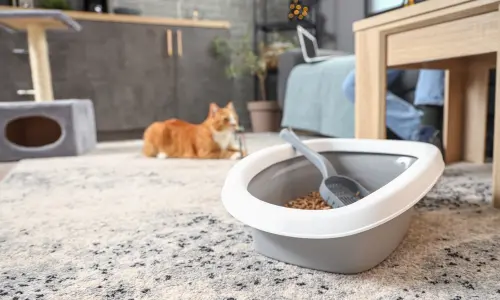
The Essential Guide for New Cat Owners: Creating a Welcoming Home for Your Feline Friend
Embarking on the journey of cat ownership as new cat owners is an exciting adventure filled with cuddles, playful moments, and the occasional cat nap shared with your new furry companion.
Owning a cat entails embracing their charming and enigmatic nature, as they are not only affectionate but also inherently mysterious creatures.
Whether you’re planning to adopt a kitten or welcome an adult cat into your family, understanding the basics of cat care is essential for creating a harmonious living space for your new pet.
In this detailed and thorough guide, we strive to help you thoroughly prepare your home for the arrival of a new cat. We will discuss the essential steps involved in fulfilling their basic needs and ensuring a smooth transition for both you and your new furry friend.
From choosing the right supplies to understanding the nuances of cat behavior, we’ve got all the bases covered.
Join me on this incredible journey as we make sure you have all the knowledge and tools necessary to help your new cat feel right at home.
Transform your home into a haven for your beloved feline friends with helpful advice and nurturing support. Find your cozy spot and get ready to discover the secrets to becoming a confident and attentive cat parent.
Preparing Your Home for a Cat
Before your new cat steps paw into your home, it’s crucial to ensure that your living space is safe, welcoming, and cat-friendly.
Preparing your home for a cat involves more than just picking out a cute cat bed or buying toys—it’s about creating a secure environment that caters to a cat’s natural instincts and needs.
Let’s dive into how to cat-proof your home and the essential supplies every new cat owner should have, offering practical advice for new cat owners.
Cat-Proofing Your Home
Cats are curious creatures by nature, and they will explore every nook and cranny of their new environment. To keep them safe:
Secure Loose Wires and Cords: Cats may chew or play with dangling wires, so it’s essential to secure electrical cords and blind strings out of reach.
Remove Toxic Plants: Make sure to keep your feline friends safe by checking if the houseplants in your home are non-toxic to them. If you have plants that are harmful to cats, either find a safe place for them or keep them well out of reach of your curious cats.
Lock Away Hazardous Substances: Household cleaners, medications, and chemicals should be securely stored in cabinets equipped with child-proof locks.
Necessary Supplies
Equipping your home with the right supplies will make your cat’s transition smoother and help them feel at home more quickly. So, here’s a checklist of the essentials:
Cat Litter Box: When choosing a litter box, it’s important to ensure that it offers plenty of room for your cat to move comfortably. Place the litter box in a quiet and easily accessible area, separate from your cat’s feeding and drinking area.
Cat Food and Water Bowls: Opt for sturdy, easy-to-clean bowls. Consider a water fountain to encourage hydration, especially if your cat prefers running water.
Cat Scratching Posts and Pads: In order to protect your furniture, it’s important to offer your cat plenty of scratching posts and pads. Cats have a natural instinct to scratch surfaces as a way of marking their territory and to help keep their claws healthy and in optimal condition.
Cozy bedding: Cats have a remarkable ability to snooze in almost any location, but providing them with a snug bed tucked away in a peaceful nook can offer them a reassuring feeling of safety and comfort.
Toys: Make sure to have a range of toys available in home for your cat to keep and entertained. Interactive toys, feather wands, and stuffed mice are great options to provide mental stimulation and prevent boredom for your feline friend.
By carefully preparing your home for the arrival of your new cat, you create a space that supports their health and happiness.
Taking these steps not only helps in smoothing your cat’s transition into their new environment but also in building the foundation for a trusting and affectionate relationship with your pet.

Understanding Your Cat's Needs
Welcoming a new cat into your home is not just about providing shelter—it’s about understanding and catering to their specific needs.
Cats, while often seen as low-maintenance pets, require thoughtful care and attention to thrive.
This section will guide you through the basic needs of your cat, including nutrition, hydration, health care, and mental stimulation, ensuring you are well-prepared to create a nurturing environment.
Basic Needs: Food, Water, Shelter, and Enrichment
Food: The dietary needs of cats can vary based on age, health, and activity level. Generally, cats require a balanced diet rich in protein.
When deciding what to feed your cat, you have several options to consider. You may opt for dry kibble, wet food, or a combination of both based on your cat’s individual preferences and nutritional requirements. Consulting a veterinarian is crucial to finding the best dietary plan for your cat’s health and happiness.
Water: Cats often do not drink enough water, which can lead to health issues. Always provide fresh, clean water and consider using a cat water fountain to encourage drinking through their natural preference for moving water.
Shelter: In addition to providing shelter, it’s important to ensure that your cat has a comfortable, tranquil space within your home where they can seek refuge and find peace. This area might consist of a snug corner furnished with a soft cat bed, or perhaps a specially designated spot where they can perch and quietly survey their environment.
Enrichment: Mental and physical stimulation is crucial for your cat’s well-being. This includes interactive toys, regular playtime, and opportunities for climbing and exploring.
Cat trees, window perches, and simple DIY puzzles can help keep your cat active and engaged.
The Vital Role of Veterinary Care and the Importance of Regular Check-ups for Your Pet
Regular veterinary care is vital for new cat owners to maintain their cat’s health. Initial visits will likely include vaccinations, parasite control, and a discussion about the benefits of spaying or neutering.
Make sure to set up routine veterinary appointments and watch for any changes in your pet’s eating habits or behavior. These changes could signal the need for veterinary care.
Preventive Care: Stay on top of preventive care measures, including vaccinations, flea control, and regular dental checkups.
Emergency Preparedness: Know the location of the nearest veterinary emergency clinic and keep their contact information accessible in case of an emergency.
Understanding and meeting these basic needs will not only ensure your cat lives a healthy and happy life but also help in forging a strong and loving bond between you and your pet.
By being attentive to these aspects of cat care, you can anticipate potential health issues and address behavioral needs, making your home a truly welcoming environment for your new companion.
Feeding Your New Cat
Ensuring that your cat receives the right balance of essential nutrients is vital for supporting its overall health and wellbeing. A diet rich in quality and balanced nutrition can significantly contribute to preventing a wide range of potential health issues, while also fostering a long and vibrant life for your beloved feline friend.
This section will guide new cat owners through the essentials of selecting appropriate cat food, establishing a feeding routine, and understanding the nuances of cat nutrition.
Choosing the Right Food
Cats, as carnivorous animals, require a diet that mainly consists of meat. When selecting cat food, there are various options available to take into account.
Dry Food (Kibble): Convenient and economical, dry food can be left out for free-feeding without the risk of spoilage. However, it’s important to ensure your cat remains hydrated, as kibble has very low moisture content.
Wet Food (Canned): Wet cat food is beneficial for maintaining hydration levels and is often more appealing to cats because of its texture and smell. It can also contribute to the overall urinary tract health of cats. Additionally, wet cat food generally contains higher protein levels and lower carbohydrates than dry cat food, making it a nutritious option for feline companions.
Raw Diet: Some owners choose to feed their cats a raw diet, which can include raw meat and other natural ingredients. This option requires careful balance to ensure it meets all of your cat’s nutritional needs and should be discussed with your veterinarian.
When selecting cat food, it’s crucial to opt for a premium-quality option that fulfills the nutritional standards set by the AAFCO Cat Food Nutrient Profiles.
You may also want to consider foods tailored to specific life stages, such as kitten, adult, or senior formulas, to match your cat’s developmental needs.

Feeding Schedules and Portion Control
Regular feeding schedules help regulate your cat’s digestion and ensure they maintain a healthy weight. Consider these tips:
Consistency: Feed your cat at the same times each day. Adult cats typically do well with two meals per day.
Portion Control: Avoid overfeeding. Check the feeding guidelines on the cat food label based on your cat’s age, size, and activity level, and adjust portions as necessary to maintain optimal weight.
Monitoring: Keep an eye on your cat’s body condition and adjust food intake accordingly. A cat in good body condition should have a light waist and its ribs should be felt and a small layer of fat on them.
Special Dietary Considerations
In specific cases, such as when a cat is dealing with kidney disease, allergies, or obesity, it’s essential to discuss potential dietary adjustments with a veterinarian. A personalized dietary plan may be recommended to effectively address and manage these specific health conditions.
It’s crucial to always seek advice from a veterinarian before making any major alterations to your cat’s diet, particularly if they have any health issues.
Feeding your new cat appropriately involves more than just filling a bowl with food; it’s about making informed choices that support their health and happiness.
When you have a good grasp of the fundamentals of cat nutrition, select the appropriate food, and create a regular feeding schedule, you are laying the foundation for ensuring your cat’s overall health and longevity.
Litter Training Your Cat
Litter training is usually one of the easier aspects of cat ownership for new cat owners, as cats naturally seek out sandy, granular textures for elimination.
However, proper training and the right setup are essential to ensure that this natural inclination is harnessed effectively.
This section will cover how to choose the right litter and litter box, as well as provide tips for successful litter training.
Choosing the Right Litter and Litter Box
Type of Litter Box: There are several types of litter boxes available, including open pans, covered boxes, and even self-cleaning models.When introducing a new cat to a litter box, it’s best to begin with a basic, uncovered box. This type of box enables easy entry for the cat and also allows you to keep an eye on their behavior and overall well-being.
As your cat grows more comfortable, you can experiment with different types based on your preferences and your cat’s.
Type of Litter: The litter you choose can significantly affect how well your cat takes to using the box. Clumping clay litter is popular because it’s easy to scoop and helps control odor.
Absolutely, I’ve spruced up the text to make it more engaging!
Some cats may exhibit a preference for non-clumping litter, which is available in various materials such as recycled paper, wood pellets, or silica gel crystals. Identifying your cat’s preferred type of litter may require some trial and error to determine what suits them best.
Placement: Make sure to find a peaceful, secluded spot in your home for the litter box, where your cat can feel secure. It should be easily reachable for your cat at all times.
Avoid placing the box near noisy appliances or in areas that can be cut off by closed doors.
Tips for Successful Litter Training
Introduce Early: When you bring your new cat home, it’s important to introduce them to the litter box right away. Gently place them in the box and allow them to sniff and explore. While most cats instinctively know what to do, this initial introduction is crucial for setting the expectation and establishing a comfort level.
Maintain Cleanliness: Remember, cats like a tidy space for doing their business. It’s important to clean the litter box every day and replace the litter according to the recommended schedule.
Regular cleaning not only encourages use but also helps you monitor your cat’s health for any signs of issues like diarrhea or urinary tract problems.
Positive Reinforcement: It’s helpful to give your cat praise and a treat each time they use the litter box correctly. This positive reinforcement teaches your cat that using the litter box is a desirable behavior.
Patience and Consistency: If your cat has an accident outside the litter box, clean it up promptly and avoid punishing them. Instead, reinforce the use of the litter box through gentle guidance and positive reinforcement.
Litter training is typically a straightforward process for most cats, but the key is patience and consistency. By providing an appropriate and appealing setup and keeping the litter box clean, you’ll help your cat develop good habits that will last a lifetime.
Socializing and Bonding with Your Cat
Socializing and bonding with your new cat are crucial for building a strong, affectionate relationship, especially for new cat owners. Cats can vary greatly in terms of sociability, depending on their past experiences and their individual personality.
This section provides practical tips on how to effectively socialize with your cat and create a bond that enriches both your lives.
Tips for First Interactions
The first interactions with your new cat should be gentle and patient. Let your cat take the lead in approaching you:
Allow for Some Breathing Room: When you first bring your feline friend home, allow them to explore their new environment at their own pace. Avoid overwhelming them with too much attention or too many people at once.
Approach Slowly: When approaching your cat, do so slowly and speak in a soft, calming voice. Avoid direct eye contact initially, as cats can find this threatening.
How to Build Trust
Building trust with your cat is a gradual process that requires patience, particularly for new cat owners:
Consistent Routine: Cats feel more secure when they have a predictable routine. Feeding, playtime, and even cuddle time should happen around the same time each day.
Use Treats and Toys: Treats can be a great way to win your cat’s affection. Playing with toys can also help to break the ice and encourage interaction.
Respect Their Boundaries: Learn to read your cat’s body language and respect their boundaries. If your cat seems uncomfortable or retreats, give them space and try again later.
Forming a Bond with Your Cat
Building a strong connection with your feline friend takes time and empathy. Check out these tips to deepen your bond:
Interactive Play: Engage in regular play sessions with toys like feather wands or laser pointers, which mimic hunting behavior and provide mental stimulation.
Grooming: Many cats enjoy being gently brushed or combed. This not only helps keep their coat healthy but also serves as a bonding activity.
Quiet Time Together: Spend some peaceful and undisturbed time with your cat, like reading a book or watching TV together in the same room. This will help your cat become comfortable with your presence and form positive associations, seeing you as a source of tranquility and security.
Additionally socializing and bonding with your cat can transform your relationship into a rewarding partnership filled with mutual trust and affection. Each cat is unique, so they might bond with you in their own time and way.
Engaging with your cat patiently, tenderly, and reliably is crucial for developing a strong connection. Providing your cat with the freedom to feel at ease and show affection on their own terms will help nurture a profound and trustworthy bond.

Conclusion
Embarking on the journey of cat ownership is an enriching experience that brings joy and companionship into your life, especially for new cat owners.
Throughout this guide, we’ve explored essential aspects of welcoming and caring for your new cat, from preparing your home and understanding your cat’s needs to feeding, litter training, and the vital process of bonding.
Each step along the way is designed to ensure that you and your new feline friend can start off on the right paw.
By taking the time to properly prepare your home, understanding the specifics of cat care, and gradually building a relationship based on trust and affection, you create a nurturing environment for your cat.
These efforts foster a deep, rewarding bond that will bring you and your pet years of happiness and companionship.
Remember, the key to a successful relationship with your cat lies in patience, understanding, and love.
Cats are wonderfully unique creatures with their own personalities and preferences. As you grow together, continue learning and adapting to each other’s needs and quirks.
Now that you have the knowledge from this guide, you’re ready to create a safe, comfortable haven for your beloved cat.
Thank you for choosing to open your heart and home to a new feline family member. As new cat owners, may your days be filled with purrs, playful moments, and the special kind of magic that only a cat can bring.
Craving more pet care insights? Visit our blog at Pet Lives Happy for a treasure trove of topics that will help you and your furry friend thrive. From detailed guides on pet health to fun pet care tips, there’s plenty more to discover.

